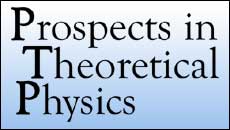| *This
schedule is subject to change.
LECTURERS and LECTURE
DESCRIPTIONS Michael
Peskin, SLAC, Stanford University
Topic: Introduction to the Standard Model (Abbreviation:
"Intro SM")
The Standard Model of particle physics and its experimental foundations:
e+e-annihilation, total cross sections, jets, heavy quarks; weak
interactions in neutrino scattering, ppbar collision, and precision
experiments at the Z; studies of W and top; a glimpse of future e+e-physics
Jonathan Bagger, Johns Hopkins
University
Topic: General Orientation to Beyond the Standard Model (Abbreviation:
"Orient BSM")
General perspective on
new physics of the 100 GeV -TeV scale. Why do we expect physics beyond the
Standard Model? What are the experimental constraints so far? Why are we
so excited about the LHC?
Dieter Zeppenfeld, University of Karlsruhe
Topic: Standard Model at Colliders
(Abbreviation: "SM at C")
Description of
hadron-hadron collider events using the parton model, general
characteristics of events, event generation and parton showers. Standard
Model reactions and tests: jet production, W and Z production,
heavy quark production. Higgs production processes.
Heidi Schellman, Northwestern University
Topic: Collider Detectors (Abbreviation:
"Detectors")
What do physics events look like at hadron colliders? Parameters of hadron
colliders. Detection methods for elementary particles: tracking, vertex detection,
calorimetry. Why are the LHC detectors designed as they are?
Lance Dixon, SLAC, Stanford University
Topic: QCD at Colliders (Abbreviation: "QCD")
Perturbative QCD
beyond the leading order: Why is this needed for collider physics? Why do
infrared divergences appear, and how do we deal with them? What does it
mean to compare theory and experiment in QCD?
Ian Hinchliffe, Lawrence Berkeley
National Lab
Topic: Signatures of Physics
Beyond the Standard Model (Abbreviation: "Sig
BSM")
Most important
signatures of new physics at colliders (missing energy, jet pairs at high ET, anomalous lepton
pair, Z, W production, heavy quark production). What models of new physics
might give rise to these signatures. What are the Standard Model
backgrounds? What will be needed to observe new physics above these
backgrounds?
Christopher Tully, Princeton University
Topic: Experimental Study of Higgs
Bosons (Abbreviation: "Higgs Exp")
Search
for the Higgs boson at LEP, and prospects for Higgs boson experiments at
the LHC.
Hitoshi Murayama, University of California,
Berkeley
Topic: Supersymmetry (Abbreviation:
"SUSY")
Review
of global SUSY formalism, SUSY models of particle physics, experimental
signatures of SUSY. Spectroscopy measurements in supersymmetry. Models of
supersymmetry breaking and their experimental implications. Can we test
string theory at colliders?
Scott Thomas, Stanford University
Topic: Exotic Signatures of New Physics at the LHC
(Abbreviation:
"Exotic Signatures")
Stable
and late-decaying particles and black holes.
Jonathan Feng, University of California, Irvine
Topic: Implications of
Particle Physics for Cosmology (Abbreviation:
"Cosmo/particle")
The
new picture of the universe from cosmology. What insights can collider
measurements give us into the issues raised by this picture? What can we
learn about dark matter at colliders?
Konstantin Matchev, University of Florida
Topic: Practicum on
Simulations
Guided exercises
illustrating the use of these simulation tools for LHC physics.
|
